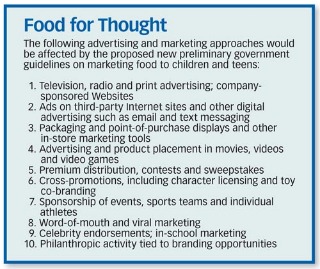Food Guides Gall Marketers

Representatives of food marketers, cable operators and broadcasters tell B&C that more than 1,700 cable and broadcast programs could be affected if the industry were to comply with new government recommendations on voluntary mandates and restrictions on marketing food to children.
Driven by the real problem of childhood obesity, which translates into adult obesity and projected billions of dollars in related healthcare costs, and by a congressional directive, an interagency working group of the FTC, FDA, USDA, and Centers for Disease Control has recommended that within five years, all foods directly marketed to kids—which includes via TV ads on cable and broadcast—meet a new set of nutritional standards, one that Richard O’Brien, executive VP of the American Association of Advertising Agencies, calls “draconian.”
The industry has already been cutting down on the sweets and boosting the veggies through the Council of Better Business Bureau’s Children’s Food and Beverage Initiative. The working group said it has examined that and other self-regulatory efforts, but suggests more needs to be done, including expanding the age range to 17 for some restrictions. Currently, the industry initiatives are targeted to kids 12 and under. And while the working group went out of its way to say the proposals are guidelines and not new regulations, the weight of those agencies tips the scale toward compliance, industry reps suggest.
O’Brien says the acknowledgement of self-regulation as the right approach is good. “What is troubling is that the suggested standards, which [the agencies] hope will be incorporated into a voluntary, self-regulation program, are so draconian,” he says. “In essence, they basically limit entirely the products you can advertise to children. So in a sense it is like a de facto elimination of a whole category of products.”
The Working Group recognizes that, saying in its report: “If the proposed nutrition principles were fully implemented by industry as proposed, a large percentage of food products currently in the marketplace would not meet the principles.” That is one of the reasons the recommendations are open to further comment and may need to be adjusted, the group says.
The guidelines would apply to virtually every means of marketing.
Jim Davidson, executive director of the Alliance for American Advertising (whose members include the major ad associations, the National Association of Broadcasters and National Cable & Telecommunications Association), says that the recommended limits on the fats, salts and sugars have been adjusted since December 2009, when initial recommendations were outlined, and that it is possible that the limits on marketing to teens may not apply to TV, but only to social media. Both of those are improvements on the original, he says.
But it is not clear what that will mean in terms of whether a particular cereal or juice is in or out, Davidson adds.
Why, however, should broadcasters and cable operators chafe against voluntary guidelines to combat childhood obesity, an acknowledged health risk?
Davidson is not implying that there is not an obesity problem, or that there aren’t steps that can be taken, but that the government has not done its due diligence in concluding that this proposal achieves that result. “Anything that would affect over 1,700 TV shows is something of concern,” says Davidson.
“It is our belief that it would take the vast majority of certain food categories off the table,” adds O’Brien, “though we are still trying to determine what specifi c brands would be affected. Beyond that, entire programs could be taken off because there would be no products to advertise in them.”
The fact that the agencies went out of their way to say this is voluntary, subject to adjustment, and not to be read as a regulatory mandate could be looked at as more of a smoke screen.
When the federal government puts its name and reputation behind a set of recommendations, says Davidson, “manufacturers, advertisers and the media are not inclined to just say no, we don’t believe in these. People want to comply with regulatory agencies.”
One former advertising agency government relations executive thinks the government is going to need to step in.
“The self-regulatory scheme set up by the food industry…was a good beginning, but it is not fair to expect marketers to come up with the next steps on their own,” says Adonis Hoffman, an adjunct marketing professor at Georgetown University and former general counsel for the 4As. “It is not in their DNA to curtail their own marketing practices.”
The FTC is still accepting comments on the proposed recommendations pending final approval.
E-mail comments to jeggerton@nbmedia.com and follow him on Twitter: @eggerton
The smarter way to stay on top of broadcasting and cable industry. Sign up below
Contributing editor John Eggerton has been an editor and/or writer on media regulation, legislation and policy for over four decades, including covering the FCC, FTC, Congress, the major media trade associations, and the federal courts. In addition to Multichannel News and Broadcasting + Cable, his work has appeared in Radio World, TV Technology, TV Fax, This Week in Consumer Electronics, Variety and the Encyclopedia Britannica.

